Navigating Fish Surfboards: A Beginner's Guide
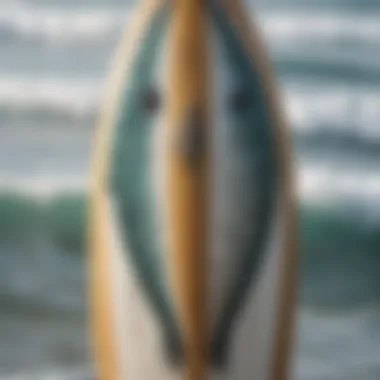
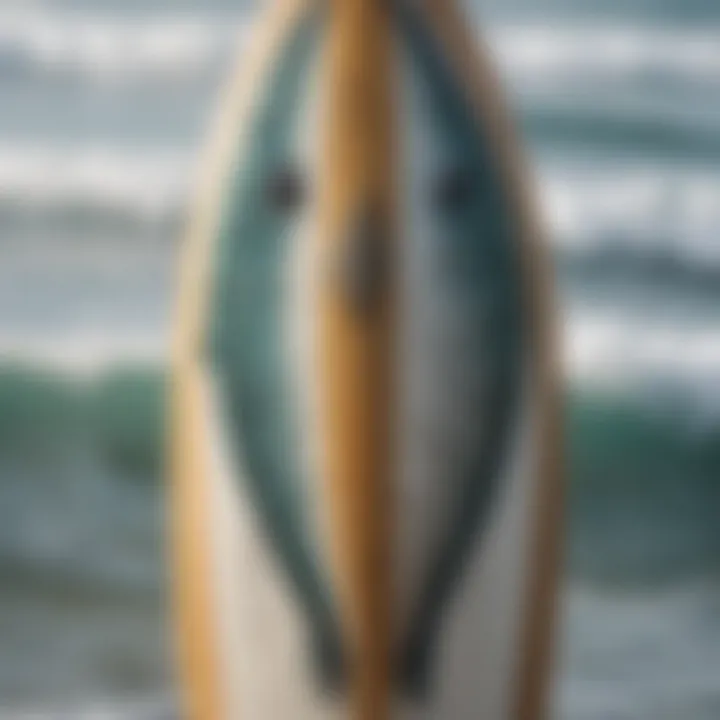
Intro
When it comes to surfing, the right board can make all the difference. Enter the fish surfboard, a favorite among those starting their journey on the waves. Its unique shape and design can help ease new surfers into the sport. In this primer, we’ll uncover the essence of fish surfboards, detailing everything from their distinctive features to essential tips for maintaining them. Understanding the ins and outs of fish boards will undoubtedly enhance your surfing experience.
Fish surfboards stand out due to their short and wide profile, often characterized by a pointed nose and a flashy tail. They’re typically shaped for catching smaller waves, yet they provide the speed and maneuverability that many surfers crave. Whether you’re simply looking to ride the waves or trying to nail your first turn, these boards are designed to give you a playful yet solid ride.
While the focus will be on equipping beginners with knowledge, we won’t shy away from exploring advanced techniques as well, ensuring that all skill levels can find value here. Moreover, maintaining a surfboard isn’t something to gloss over - it’s essential for prolonging its life and performance.
Key Features of Fish Surfboards
- Shape and Size: Fish boards are shorter and wider than traditional shortboards, making them buoyant and stable. Their unique outline allows for easy paddling and quick transitions.
- Tail Design: Many fish surfboards feature a swallowtail, which enhances maneuverability on smaller waves.
- Material Considerations: Understanding the materials used in constructing fish surfboards can influence both performance and environmental impact.
Navigating the world of fish surfboards doesn’t have to be overwhelming. As we move deeper into this guide, you’ll not only learn how to choose the right board but also how to maintain it, ensuring your surfboards stand the test of time. Let’s kick things off with some foundational surfboarding techniques.
Understanding Fish Surfboards
When stepping into the world of surfing, understanding the tools of the trade is key, and fish surfboards hold a unique place in this conversation. Designed with a purpose, fish surfboards are often regarded as the ideal starting point for beginners due to their distinct design and enhanced stability. They are crafted to ride effectively in smaller, mushy waves, which is typically where novices begin their journey. Knowing what sets these boards apart from others is essential not just for selection, but also for maximizing the learning experience.
Historical Context
Fish surfboards originated in the 1970s during a period of surf innovation. Surfers quickly discovered that a board with a wider nose and a swallowtail could better navigate lesser waves. This shape allowed for enhanced maneuverability and speed, especially in choppy conditions. Pioneers like Bob Simmons first experimented with similar designs, laying the groundwork for what would evolve into the fish surfboard we see today. Over the decades, the design went through various transformations, adapting to the needs of both pro and amateur surfers alike. Now, fish boards are not merely a footnote in surfing history but a staple for those venturing into the sport.
Design Features
Fish surfboards are distinguished by a few key design elements that contribute significantly to their performance. They tend to be shorter and wider than traditional surfboards, offering a blend of buoyancy and stability that is beneficial for beginners learning how to ride the waves.
Shape and Dimensions
The shape and dimensions of a fish surfboard are pivotal in shaping the overall surfing experience. Typically, these boards are around 5'2" to 6'6" long, allowing for better maneuverability in smaller surf. The width, often ranging between 20 to 22 inches, makes it easier to maintain balance, especially for those just standing up for the first time. This shape provides increased paddle power, allowing novices to catch more waves without expending excessive energy. Thus, it can be seen as a practical choice for beginners, offering them the confidence they might need in the early stages of their surfing journey.
Tail Types
The tail shape of a fish surfboard is another significant feature that affects performance. Most common are the swallowtail and the bat tail, each offering distinct advantages. The swallowtail, for instance, allows for quick turns and easier transitions between movements, perfect for surfers who are honing their skills. It provides increased speed because of its lifted edges, which can maneuver through small waves effectively. While this feature brings the benefit of agility, it may also require a bit of practice to master, emphasizing the importance of understanding one’s own skill level while selecting a tail type.
Fin Configuration
Fin configuration plays a crucial role in how a surfboard handles water and turns. The typical fish surfboard comes with a two-fin or thruster setup, which offers balance. This configuration helps beginners maintain control, which is a primary concern when starting out. Two fins create a looser feel, allowing for better flow in waves. On the flip side, having more fins increases stability but can make the board feel less lively. Thus, beginners often benefit from choosing a board with a two-fin setup, as it aligns well with their need to grasp the basics without becoming overwhelmed by complexity.
"Understanding the specific features of fish surfboards can dramatically improve a beginner surfer's experience. It's not just about finding a board; it's about finding the right board that works with your style and skill level."
Why Choose a Fish Surfboard?
Fish surfboards have become particularly popular among those who are just dipping their toes into the surfing world. Understanding why one would choose a fish surfboard over others can be crucial for beginners. The unique design and functional aspects of fish surfboards make them a fitting option for novice surfers looking to build confidence and skills in the water.
Advantages for Beginners
Stability in Small Waves
One of the standout features of fish surfboards is their stability in small waves. This characteristic is vital for newcomers who often find smaller, less turbulent waves to be more manageable as they learn the basics of paddling, balancing, and riding. Fish boards, with their wider and flatter bodies, offer an increased surface area that provides a stable platform, making it easier to stand and ride. This stability reduces the likelihood of wipeouts, providing a more enjoyable experience.
The unique shape of a fish surfboard means that it floats better in tiny waves. This buoyancy allows surfers to catch waves more easily and stay on them longer, which is rewarding and builds excitement. In turn, this fosters a sense of accomplishment for beginners as they gradually gain proficiency in surfing.
Ease of Maneuverability
The ease of maneuverability is another pivotal benefit of fish surfboards. Their design allows for sharp turns and quick adjustments, which can be essential when navigating through different wave conditions. Beginners will find that maneuverability plays a significant role in learning to handle their board.
The fish tail shape enables quick responsiveness. When a surfer shifts their weight, the board reacts almost instantly, allowing the rider to perform playful maneuvers. This characteristic is particularly beneficial for those learning the ropes, as it enhances confidence and encourages experimentation with various techniques, like carving turns and small airs.
Applications in Various Conditions
Best Conditions for Use
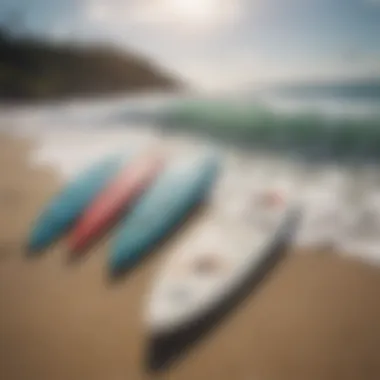

Fish surfboards shine best in small to medium wave conditions. They work wonders when the surf isn’t too big, giving surfers the chance to practice their skills without feeling overwhelmed. This makes them an ideal choice for beginners who are still finding their feet. Moreover, the design of fish boards allows them to perform surprisingly well in choppy waters, which can be a common sight at surf spots.
The versatility of these boards means that, as conditions shift, a new surfer can continue to learn and adapt on the same piece of equipment. In essence, the functionality of fish surfboards encourages a smoother learning journey through varying water conditions.
Limitations in Performance
While fish surfboards have many advantages, they do come with limitations. In larger and more powerful waves, they may underperform compared to other designs, such as thrusters or shortboards. One key aspect to note is that due to their shape, they do not generate speed in steep waves, which can be frustrating for beginner surfers who may not yet know how to catch bigger waves effectively.
It's also worth mentioning that those who outgrow the fish style may find themselves needing a different board design as they advance their skills. Recognizing these limitations is essential for beginners, as it helps set realistic expectations about what fish surfboards can achieve.
"A fish surfboard is like a supportive friend, keeping you steady until you're ready to take on the bigger waves."
This ecological consideration is also why many surfers gravitate towards the fish design, viewing it as a tool to grow into their surfing skills gradually, rather than jumping into a steeper learning curve too soon.
Selecting the Right Fish Surfboard
Choosing the right fish surfboard is crucial for beginners. It significantly influences how one experiences the waves, maneuvers in the water, and overall enjoyment of the sport. A well-selected board caters to the wearer’s body measurements and surf skills, allowing for a learning curve that is not overwhelming but still challenging. Wrong choices can lead to frustration and hinder the initial excitement that comes with catching those first waves.
Sizing Considerations
Weight and Height Factors
When it comes to surfing, weight and height play a big role in how a board performs. Generally, a good rule of thumb is to select a surfboard that’s roughly one to two feet taller than an individual’s height, but weight should also be a key consideration. A heavier surfer often needs a larger board to maintain stability, especially in rough waters.
One distinct characteristic of this factor is buoyancy. The right size helps the board float better, translating to easier paddling and quicker catches on waves. If someone who weighs significantly more than average opts for a smaller board, they might find it tough to ride in any but the gentlest swells. Therefore, understanding this relationship becomes not just beneficial but essential for a fruitful surfing experience.
Skill Level Impact
Skill level also dictates the type of fish surfboard one should choose. For beginners, a board that is forgiving and easy to manage is vital. The key characteristic of recognizing skill level is that it doesn’t simply relate to time spent on the water, but also one's comfort and confidence level when attempting various maneuvers.
For instance, a beginner who picks an advanced board will have a steep hill to climb when it comes to performance. Many novices tend to underestimate their need for stabilization, which can lead to a less enjoyable experience. Survivors of poor board choices often cite wishing they had started on a more user-friendly option that eased them into the sport with grace, rather than the clumsy struggling associated with more advanced boards.
Material Choices
Foam vs. Epoxy
Material is another significant aspect in choosing a fish surfboard. The debate between foam and epoxy boards has been a long-standing one. Foam boards, generally more economical, are softer and provide a lot of buoyancy, perfect for beginners. They are somewhat more forgiving when it comes to minor bumps and scrapes, unlike the more fragile epoxy and fiberglass boards.
Epoxy boards, on the other hand, tend to be stiffer and can hold their shape better over time. The harder surface picks up speed more readily, making it a better choice for those who are ready to advance their skills. However, for beginners, the risk of damage in case of dings or crashes often sways the decision back toward foam.
The unique feature of foam boards is they tend to be lighter, making it easier for a beginner to handle in the water. The trade-off here is that they may not simulate the same performance characteristics that one would look for as skills evolve.
Environmental Impact of Materials
In today’s environmentally-conscious world, the materials used in surfboards can no longer be an afterthought. The environmental impact of surfboard materials looks at the interaction between surfing and sustainability. Traditional surfboards have been associated with significant waste and pollution due to the chemicals used in their construction.
Fish boards made from greener alternatives not only help in preserving the marine environment but also resonate with eco-friendly surfers. They serve as a reminder that the sport can evolve to become more responsible. A notable aspect is that these sustainable materials often come with a slightly higher price tag. However, many are willing to invest more if it means contributing positively to the ocean that they love to surf in.
The choice of materials is vital not only for personal performance but for the state of our oceans as well.
Basic Techniques for Beginners
Learning how to ride a fish surfboard involves getting acquainted with some fundamental techniques. Mastering these basic skills offers beginners a solid foundation, which in turn builds confidence and enhances the overall surfing experience. Whether you're navigating gentle beach breaks or catching a few small waves, these techniques help you blend seamlessly into the action.
Paddling Techniques
Body Positioning
One of the most crucial aspects of paddling on a fish surfboard is body positioning. The way you lie on the board impacts your speed and stability in the water. For best results, keep your body centered and your chest up. This alignment helps reduce drag and allows your paddle strokes to be more efficient. A common mistake for beginners is to have too much weight in the back of the board, causing the nose to sink, which can make paddling feel like a chore. By keeping your torso forward, you maintain buoyancy in the nose, allowing you to glide.
The key characteristic of optimal body positioning is balance; it’s not just about where you lie, but how you distribute your weight.
"Effective paddling is all about finding your center of gravity and staying mobile."
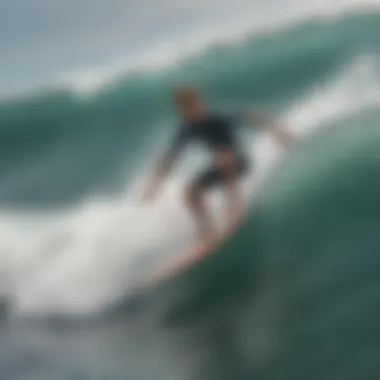
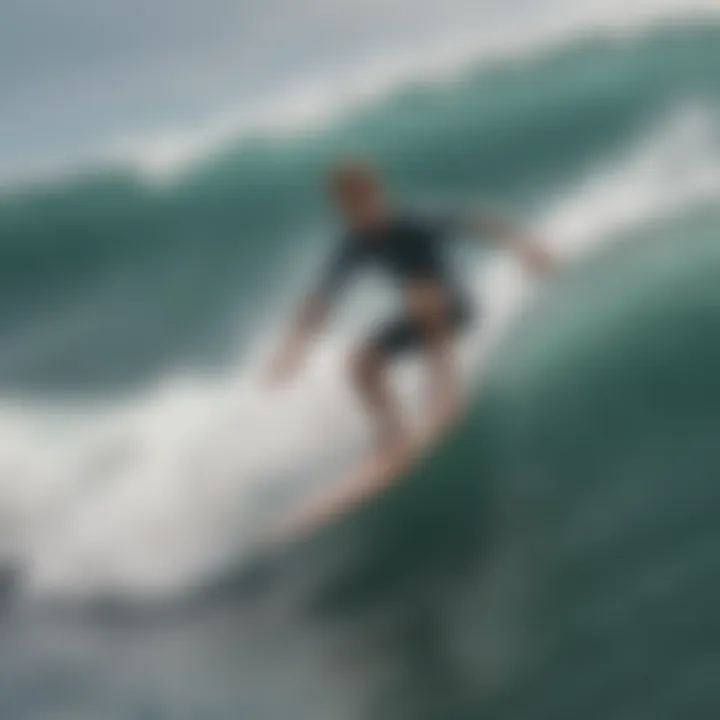
Advantages of proper body positioning include better control during waves and less energy expended while paddling out. Conversely, a disadvantage for a beginner might be a feeling of awkwardness at first, but with practice, it becomes second nature.
Effective Paddle Strokes
Associated closely with body positioning are the effective paddle strokes. The efficiency of your strokes can act as a significant factor in how well you navigate the water. Your arms should execute a deep and wide arc, pulling the water rather than just swiping at it. With each stroke, aim to rotate your torso slightly, engaging core muscles. This movement is a vital part of effective paddling.
The importance of this technique cannot be overstated—it directly correlates to how quickly you can gain momentum. A vital characteristic of effective strokes is their ability to maximize speed without tiring you out, which is essential for beginners who might not have built up endurance yet.
Disadvantages include the initial learning curve; improperly executed strokes can lead to quick fatigue. But with practice, you’ll find your rhythm and improve your paddling efficiency.
Standing Up
Foot Placement
Once you've navigated into the wave, the next skill is foot placement on your fish surfboard. Correctly positioning your feet can determine how well you pop up and balance on the board. When you stand, your feet should be about shoulder-width apart, with one foot slightly in front of the other for better stability. This positioning allows you to shift your weight as needed easily.
A key characteristic of good foot placement is that it prevents wobbling and helps maintain your center of gravity, which is vital when it comes to catching and riding waves. A common tip for beginners is to imagine your feet as two anchors; if they're not in the right spots, you'll likely end up disappearing into the ocean.
Advantages are clear; good foot placement provides better control and responsiveness. The disadvantage of poor foot placement can lead to falls or loss of momentum.
Timing Your Pop-Up
Another significant technique is the timing of your pop-up. Timing is critical; pop up too early, and you'll miss the wave, too late, and you risk falling back into the water. When you feel the wave begin to lift you, that’s your cue! You should push up from the bottom, placing your knees first before transitioning to your feet.
The beauty of timing your pop-up lies in its impact on wave catching; the better your timing, the smoother your transition to a standing position. A well-timed pop-up can mean the difference between skimming on top of the wave or tumbling back into the ocean.
While the advantage of mastering this skill is clear—achieving a seamless ride—the downside is that it requires practice, which may lead to some frustrating falls initially. But remember, every experienced surfer was once a beginner too.
Turning and Maneuvering
Weight Distribution
When it comes to weight distribution, this is the backbone of effective maneuvering on a fish surfboard. Shifting your weight from your back to front foot enables you to turn sharply or maintain speed. When you want to go faster, lean towards the front, and to initiate a turn, shift your weight to the back. It's almost an art form, learning how to transfer weight fluidly without over-exaggerating.
A significant characteristic of efficient weight distribution is its ability to change the board's direction with minimal effort. Beginners often misunderstand this balance, leading to less control in their turns.
Advantages include improved turning ability and stability while riding. One of the disadvantages is that poor weight management can lead to wipeouts, and that can be discouraging at first.
Fin Usage for Turns
Finally, understanding fin usage for turns is essential for making the most of your fish surfboard. The fins are not just there for aesthetics; they provide the grip needed to maintain control while surfing. By leaning into your turns and applying pressure to the fins, you can carve more effectively. The right fin settings depend on your style and the conditions you're surfing in.
A key feature of fin usage is that it enhances maneuverability. It allows beginners to feel like they have the necessary control over their ride, boosting confidence significantly.
While the advantage is the ability to make sharper turns, a downside could be that beginners may get confused about the right amount of pressure to apply. Too little, and you might slide out, but too much can lead to losing control altogether.
Maintenance and Care for Fish Surfboards
Maintaining your fish surfboard isn’t just about keeping it looking good; it's about maximizing its performance and lifespan. A surfboard, especially a fish type, can be quite the investment, both in terms of money and the experiences it brings. Regular upkeep can prevent those pesky damages that happen after a tumble or two in the waves, and knowing how to care for it can save you from costly repairs later on. In a nutshell, think of maintenance as your ticket to reliable and enjoyable surfing experiences.
Cleaning and Storage
Proper Cleaning Techniques
The foundation of caring for your fish surfboard starts with effective cleaning. After each session, rinsing your board with fresh water is essential. Saltwater can be abrasive. Leaving it on the board can lead to peeling and erosion over time. This simple act—just spraying off your board—might seem trivial, but the long term benefits are huge.
A key characteristic of good cleaning practice includes the use of a soft cloth to wipe your board down after rinsing. Not only does it remove residual grime, but it also helps in drying the board faster, reducing the chance of mold or similar issues forming. Soap or cleaning products specifically designed for surfboards can be beneficial, but ensure they are gentle. Rubbing alcohol is a good option for light spots but be careful not to overdo it; the goal is to keep your board clean without damaging the surface. As for disadvantages, harsh chemicals can wear out the materials over time, so always opt for gentle solutions.
Storage Recommendations
How you store your fish surfboard is just as critical as cleaning it. Proper storage can prevent warping, fading and unnecessary stress on fins and tail. Ideally, keep your board in a protective bag, especially the padded kind. This helps shield it from sunlight and impacts when it’s not in use. In terms of location, avoid direct sunlight—over time, UV rays can degrade the board's materials. It can also be wise to store the board horizontally rather than vertically to avoid pressure points that might cause dings.
Another aspect that isn’t often considered is humidity. Keeping your board in a climate-controlled area will prolong its life. Damp basements or hot attics are no friends to your board, so treat your surfboard storage as a zen zone. All in all, the vital feature of proper storage lies in its ability to maintain the board’s integrity long-term, ensuring you're ready to hit the waves when the opportunity strikes.
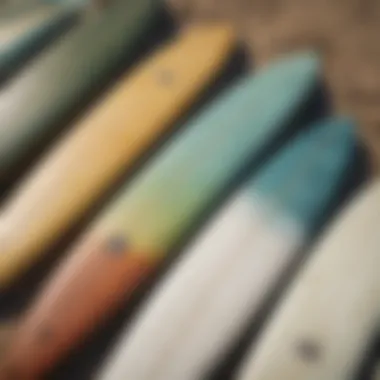

Repair Essentials
Identifying Minor Damages
Regular inspections of your board can save it from further damage down the line. Identify minor damages before they blossom into serious issues. Check for dings, cracks, or delamination frequently and assess even slight imperfections, such as scratches or abrasions. These signs are often subtle but can compromise your board’s performance, especially regarding buoyancy and stability.
When it comes to the key feature of identifying these issues, having a trained eye can benefit significantly. Make it a habit to inspect your board after every surf session, not just when something feels off. Plus, look out for water seeping into the foam; if you see moisture inside your board, it can lead to more significant problems. While most damages can often be repaired, keeping on top of things lets you catch them early, avoiding costly fixes.
DIY Repair Techniques
If you happen to find yourself with some damage, you might want to try your hand at some DIY repairs. It can be daunting at first, but with some basic supplies and a little patience, you can tackle minor dings and cracks yourself. You'd need items like epoxy resin, sandpaper, and possibly a brush or spatula for application.
The key characteristic in this case is accessibility. Most surf shops supply repair kits that are straightforward to use, ideal for beginners. The unique feature of DIY repairs lies in cost-effectiveness, allowing you to save time and money instead of heading to a professional shop. However, keep in mind that not all repairs are suitable for DIY. Some extensive damages may need expert help. Stick to minor repairs to ensure your board remains in solid shape!
Proper maintenance and care are essential to prolong the life and performance of your fish surfboard. Small efforts in cleaning and storing can keep your board ready, while being attentive to damages and learning simple repairs can save you from major inconveniences down the line.
Joining the Surfing Community
Getting involved in the surfing community is a crucial aspect for anyone looking to embrace the world of fish surfboards. Not only does it provide opportunities for learning and improving skills, but it also creates a supportive environment where enthusiasts can share experiences, tips, and even some good-humored stories. The value of connecting with fellow surfers extends beyond the sport itself; it cultivates friendships, fosters an understanding of local surf culture, and promotes a sense of belonging.
Finding Local Surfing Clubs
Locating a nearby surfing club can be a game changer for beginners. These clubs often host regular meetups and lessons tailored to suit newcomers, allowing them to learn essential techniques in a group setting.
- Benefits of Clubs:
- Access to experienced surfers who can share valuable insights.
- Opportunities to participate in special events or contests.
- A chance to ride with others, enhancing the overall experience.
Joining a local club can also introduce you to various surf conditions. You might be shown the ropes at popular spots or less-known gems where the waves roll in just right. Making connections can help you gain confidence as you progress in your surfing journey.
You can find these clubs through local surf shops, community centers, or social platforms like Facebook. Many clubs maintain an active presence on social media, sharing updates and organizing group outings.
Participating in Surf Events
Get ready to elevate your experience by joining surf events. These events range from friendly competitions to social gatherings that celebrate the sport. Participating in these not only boosts your skills but also energizes your love for surfing.
- Why Participate?:
- Skill Development: Events often include workshops or sessions that focus on technique and tactics, improving your proficiency on the fish surfboard.
- Networking: You meet diverse individuals, from seasoned pros to fellow novices, developing lasting connections.
- Community Building: Being part of an event helps you understand different surfing styles and perspectives, enriching your overall experience.
"Surfing is much more than a sport; it's a lifestyle that brings people together. The thrill of the waves is amplified when shared with others."
Events are often organized at various surf spots and can be found advertised on local surf shop boards, community websites, or platforms like Reddit. Look out for festivals, competitions, or charity events that encourage participation.
Engaging with the surfing community enriches your journey significantly, making it both rewarding and enjoyable. From local clubs to thrilling events, you get to dive into the soul of surfing—a pursuit of joy, adventure, and camaraderie.
Environmental Considerations
The discussion around fish surfboards is not complete without addressing a significant aspect that affects surfers, the oceans, and future generations: environmental considerations. In recent years, there is a growing awareness about the impact surfing gear can have on our planet. Eco-conscious surfers are increasingly seeking products that not only enhance their riding experience but also minimize the environmental footprint. Understanding the implications of sourcing materials, the manufacturing process, and how one rides in these natural ecosystems is fundamental to fostering a sustainable surfing lifestyle.
Sustainable Surfboard Manufacturing
Sustainable surfboard manufacturing focuses on creating boards that utilize eco-friendly materials and processes. Traditional surfboards made from polyurethane foam often pollute the environment during production and at disposal. However, there are brands making strides in adopting greener practices. For example, some companies utilize bio-resins derived from renewable resources such as soy and plant oils. These bio-resins can be less harmful compared to their petrochemical counterparts.
Additionally, recycled materials have begun to find their way into the surfboards of the future. From using reclaimed wood for the boards to incorporating recycled plastics, manufacturers are innovating to reduce waste and promote recycling efforts. When browsing for a fish surfboard, pay attention to details such as whether the board is designed for longevity, as a well-made board can serve for years, ultimately minimizing waste.
"Greener surfboards not only ride waves but also protect them for the next generation."
Conservation of Surfing Spots
Protecting our surfing spots is vital as many popular locations face threats from climate change and human activities. Overcrowding, pollution, and coastal development are just a few of the issues that can degrade these natural environments. As surfers, there's a responsibility to advocate for the conservation of these precious spaces.
Being active in local conservation efforts can be particularly impactful. Joining or supporting organizations that focus on keeping beaches clean and preserving marine ecosystems can make a world of difference. It’s essential to practice the principles of 'leave no trace' when heading out for a surf session. Simple habits like picking up trash or minimizing your water use can contribute to the longer-term health of ecosystems.
Here are some actionable steps for surfers to consider:
- Participate in local beach clean-ups regularly.
- Support policies aimed at protecting coastal habitats.
- Educate fellow surfers and locals on the importance of marine conservation.
By taking these considerations seriously, surfers contribute to safeguarding the beauty of the ocean, ensuring that future generations can enjoy the thrill of riding waves like we do today.















